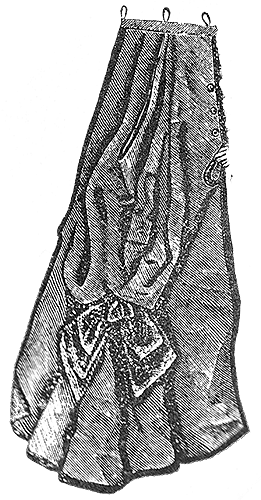I have been busy creating new patterns for the late 1880’s, and the one thing that stands out as unique about this time period is the Burnous Pleat. Just about every skirt from 1887 – 1888 has some kind of drape created by this form of pleat. Something else I found out, is that no one seemed to know how to spell the word “burnous”. I even found it spelled two different ways in the same sentence. So if you see Bournous, Bournouse, Burnous, Burnouse, or Burnoose, it all means the same thing. And yes, I seem to spell it all different ways as well, in my various instruction sheets.
So what exactly is a Burnous pleat? Well, it is one of those simple things that is very hard to describe, because we don’t use this type of pleat in modern sewing. Nor really do you see it in any other time period. So the concept is foreign, and almost unimaginable, until you see it.
The technical description: A large fold of fabric, like a very wide pleat, where the top edge is unsupported and is left to hang down in a loop.

 .
. 
And this is what it looks like after the pleat is put in. Pretty ingenious, right? I just love this!
And this is just the beginning. Want to make a court train out of velvet, but there is no way you can put 90″ of velvet into 6″ of waistband? Use two burnous pleats. Not only do you take away at least half of the bulk, it adds in pretty cascades.

Just like in our new TV263 – 1887 Imperial Skirt pattern.
Or even three, as shown in this 1888 skirt from The Delineator.

And how does this pleat get you around corners? Find out in our upcoming orverskirt pattern TV367 – 1887 Cascade Overskirt!
